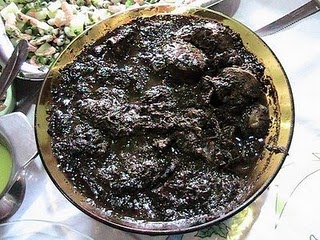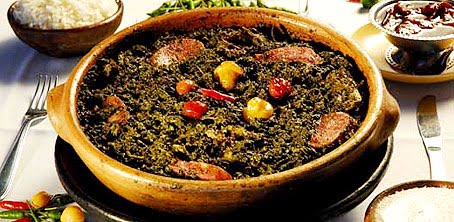Maniçoba
“One man’s poison ivy is another man’s spinach.”
-George Ade (1866-1944) American humorist
To a westerner, most of the traditional dishes here in Belém seem a little strange – Maniçoba (pronounced ma -nee-SO-ba) is definitely no exception. It looks completely unappetizing – it’s a thick, mud-like, almost black chunky puree studded with pieces of indistinguishable smoked meat, salted pork, and sausage, served over rice. If it weren’t for the overwhelming amount of people who enthusiastically told me “You HAVE to try this while you’re in Belém!!” , I probably would have skipped it altogether.
Maniçoba takes at least 4 (preferably 7-8) days to cook. It’s primarily made out of fresh manioc leaves that have been ground into a fine green paste with a mortar and pestle (nowadays, mechanical grinders are used for large-scale production, but many indigenous families still grind it by hand). Like the manioc itself, the leaves contain a potentially lethal concentration of hydrocyanic acid (cyanide) – after 4 days of continuous boiling, the toxin is destroyed and it is safe for human consumption. Most people cook it for several more days to improve the flavor of the leaves. After 4 days, they’re still slightly green and bitter – the longer they cook, the darker they get and the flavor mellows out to something a little more palatable. The taste of maniçoba is hard to describe – it’s a hearty, rich, smoky, almost burnt flavor with very strong earthy undertones, and a very distinctive aftertaste. It overpowers almost everything else you’ll eat with the meal. It’s served over rice, topped with coarse-ground manioc flour, and garnished with pimenta-de-cheiro, the local hot pepper.
Maniçoba is also known as the “feijoada of Pará”, substituting potentially toxic manioc leaves for black beans. It’s yet another dish that you won’t be able to find anywhere else in the world (can you imagine the FDA actually approving something like this? 🙂 ). Maniçoba started out as a traditional dish accompanying the Cirío de Nazaré, which is the area’s largest religious festival held in late October. It quickly gained popularity and can be found in almost every restaurant in the area offering typical regional foods.
The word “maniçoba” is a combination of several indigenous words: mani (manioc)+ so (to undo or cut) + mba (entirely/completely) – “to completely undo manioc”. When the Portuguese arrived, manioc had already been completely domesticated and the native people were thoroughly knowledgeable regarding its many uses. The Portuguese added the salted meat, bacon, blood sausage, and a few of their own preferred seasonings, and created a fusion dish that has stood the test of time.
In the mercado ver-o-peso in Belém, you can buy manioc leaves already ground up and ready to use. During the last weeks of October, the markets are filled with indigenous men and women tearing the leaves from the stems by hand.
The locals say that you can tell if a maniçoba is good by the green track it leaves on the back of a spoon.




Gee, I’m so sad that I wasn’t there to try this with you. It looks so incredibly delicious, and the fact that it’s made with, essentially, a poisonous plant makes it just that much more tempting. Another of those dishes that leaves me scratching my head and wondering how & WHY someone ever bothered to figure out that this deadly plant actually could be eaten. Incredible.
It’s crazy, right? You have to wonder how many people died trying the recipe at different stages.